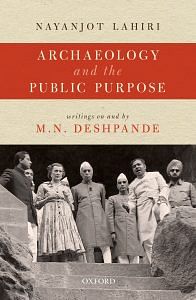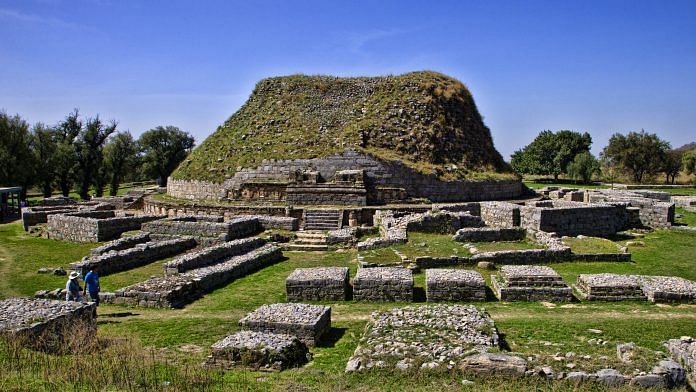Following the Great Depression of the 1930s, the ASI had reached an unusually low ebb. Archaeological work was not being carried out through any sustained policy, nor were defects in the technical training of its cadres being addressed. The personnel pool had shrunk alarmingly because of a retrenchment policy that had resulted in the organization being surgically and unwisely pared. In the junior ranks, for instance, the Survey was so inadequately staffed that no trained succession to the senior posts could be guaranteed. There were, in fact, a mere three junior officers as against eleven senior posts that had to be filled in the early 1940s. These were highlighted in a 1938 report penned by the British archaeologist Leonard Woolley, who had come to India on the invitation of the Indian government.
It was he who apparently advised the government to appoint for a limited term a director general or advisor who was not an ASI man so that problems could be addressed with a disinterested eye. Accepting his advice, Mortimer Wheeler was appointed in 1944.
Among the first deficiencies that Wheeler decided to address was the scarcity of junior archaeological staff and inadequate archaeological training. He proposed to set up a field training school in Taxila. The most promising students, as he knew, were those at universities; the director general made a determined bid to identify suitable scholars there and eventually employ them. With that in mind, earlier that year, he made an urgent appeal to nineteen university vice chancellors, for the recruitment of young university graduates for organized research and training in Indian archaeology. Wheeler also had a clear sense that if the study of India’s heritage was to advance, one necessary condition would be the extension of research from a government department to the corridors of universities, from the monopoly of the civil servant to the free initiative of the educated public. When he prepared a note a little later for the Standing Committee of the Indian Legislature on Education, he did not mince his words in describing the state of research in universities.
The extract from that note reproduced here not only reveals Wheeler’s intellectual clarity on this matter but also underlines that contrary to public perception that bureaucrats are obsequious by conviction if not compulsion, there have been government officers who have addressed legislators in a brutally frank way:
You, gentlemen, are the Standing Committee on Education. I venture to ask you: Where in India today is there a university institute, even a university department, properly staffed and equipped to interpret, in humanistic and scientific terms, this unsurpassed inheritance? The answer is, Nowhere. I take off my hat to one or two of your universities—Calcutta, Benaras—for their earnest cries in the wilderness. But my answer remains the same. Occasionally in Ph.D. theses—but very rarely—I find a faint and usually sentimental consciousness that this great inheritance exists; but nowhere do I detect any persevering attempt to understand it, in the only sense in which the word understanding can today be used. For it cannot be too often stressed that a great building or an ancient city are not merely centres of sentimental pilgrimage; they are, above all, sources of knowledge and of inspiration. That is what I mean by understanding.
I would emphasise that this gap in our educational system is not merely a gap in a branch of research which concerns only a few misguided experts. It is a fundamental gap in the ordinary liberal education of the ordinary man and woman. But research remains in the foreground of the picture. Research, and a high standard of research, is a basic necessity in this as in all educational subjects. It is unnecessary for me to remind you, gentlemen, that, without a high standard of research at the back of it all, even the most general education will fall short of its goal. You and I may not be able to afford a Rolls Royce car; but it is the research and endeavour implied by the Rolls Royce that, more than anything, maintains the standard of the less intricate piece of machinery with which most of us have to be content. The research carried out by the specialist is, or should be, directly reflected downwards to the educational standard even of the secondary school.
In other words, the maintenance and interpretation of our material cultural heritage is not merely a sort of private perquisite of my Department. The work of the Survey can only become effective if it is based upon and backed by an informal public opinion. And an informed public opinion can only be created by effort from the top, from our Legislature and from our universities.
Clearly, Wheeler took the system to task for removing heritage from the minds of Indians, a crime which, he believed, was as bad as a physical destruction of the country’s heritage. That is why, at the training school, he ensured access for all those in India who were involved in or who might be interested in archaeology: ASI staff, students, staff from Indian universities, museum men, and those from the archaeological departments of the princely states.
Soon after Wheeler issued his appeal to the vice chancellors, there was a swift response, one whose scale took him by surprise. Some thirty years later, in his memoir, My Archaeological Mission to India and Pakistan, he recounted his reaction. Its warmth remains undimmed by the passage of time:
The response was to me astonishing alike in quantity and quality and was almost instant. Within a few weeks more than sixty young graduates had assembled from all directions amidst the inviting facilities of Taxila and quickly settled down in an assortment of tents and huts prepared for their reception in accordance with traditional needs and usages. It might indeed be fair to claim that this was the last occasion in modern India when representatives of such a multiplicity of castes and other social variations voluntarily came together so earnestly on one spot with so unified an aim and fraught with so patent a sense of mutual good will. Such was ‘The Taxila School of Archaeology, 1944’, a tiny academic episode which those of us who shared in it like to remember with a certain pride and pleasure that may, in passing, be found worthy, perhaps, of the present casual but affectionate memorial. It was at least the first organized phase of a new Indo-Pakistan archaeology and the environment was a happy one.
Also read: Bala Hissar — the ancient citadel of Kabul that India is helping Afghanistan to restore
Wheeler had chosen Taxila because of the richness of its sites and its excellent museum, as also its amenities for housing trainees. The reference to Pakistan, though, is somewhat surprising since its creation in 1944 was some years away. However, one can understand why Wheeler wove its shadow into his retrospective narrative. For one, the students who trained at Taxila would go on to hold important archaeological positions in India and Pakistan. For another, from 1947 onwards, he would be actively involved in the partitioning of archaeological assets and in ensuring the safe passage of archaeological staff and their families across the newly created borders.
If the teacher remembered the many social and geographical backgrounds of the Taxila students, an entertaining account, also about the culturally diverse people there, would be penned by a student. Braj Basi Lal had, as a twenty-three-year-old, attended the Taxila camp in 1944 and this is what he wrote more than sixty years later:
A mess was being run for the trainees and Shri Mangat Rai was in-charge of it. He, being a Punjabi, gave preference to Punjabi food, little bothering about the taste of students from other parts of the country. The Bengalis termed his chapathis (breads) as ‘card-board cakes’, while the South Indian students very much missed their idlis, baras and sambhar … .
Referring to the trainees from South India, I am reminded of a very interesting episode. Taxila is usually cold and surely cold enough for persons hailing from South India. To cap it all, in January it became exceedingly cold to the extent that one night it even snowed (such a thing, we were told, had not happened for the past three–four decades). Next morning, we found the excavated trenches full of snow and thus it was almost impossible to work. Amongst the trainees there was Shri Anujan Achan, a member of the Archaeological Department in Kerala. Having never seen a snow-fall, he was so excited about it that he collected a handful of snow and put it in the pocket of his overcoat. Just then the boss happened to come there. Noting what Achan was doing, the boss told him to make a parcel of the snow that he had put in his pocket and send it to his home for the family to have a look at it.
The ‘boss’ was Wheeler and Lal wondered whether his remark was mere sarcasm or just a piece of innocent humour. Wheeler did have a habit of poking fun at his students and Lal himself had been at the receiving end on the very day that he first met him at Taxila. Wheeler had summoned him to his office where, while cross-examining him, he asked—since the young man was a student of Sanskrit, with no background of archaeology—whether he had come to Taxila to ‘recite the Vedas’! Surely M.N. Deshpande would have had a similar Wheeler experience since, like Lal, he too was a scholar of languages.

This excerpt from Archaeology and the Public Purpose – Writings On and By M.N. Deshpande by Nayanjot Lahiri has been published with special permission from Oxford University Press.




Excellent piece of writing. Excellent history